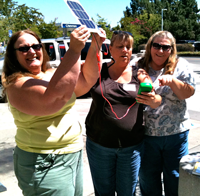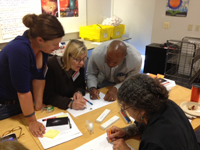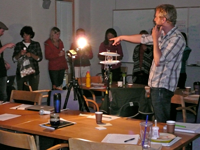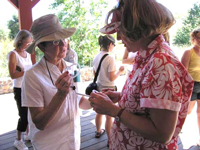Teacher Professional Development—What Do Teachers Want and Need from NASA?
[This is one of a series of blog posts about our six-year involvement leading the NASA Heliophysics Science Education and Public Outreach Forum. ]

We often ask ourselves, “What do educators really want when it comes to their own professional development (PD)?” In order to get beyond what we think they want, the NASA SMD K-12 working group carried out a national survey of over 1,000 formal and informal educators in the summer of 2012. We sent out our survey through NASA and national education networks so we could get a sense of:
- Who was using NASA resources
- What educators were looking for when using NASA resources
- What attracted them to NASA workshops and other educational opportunities.
Here is a summary of what we heard back…it's well worth a read if you are thinking about creating professional development opportunities for educators in your area!
Who is using NASA materials?
Educators using NASA materials come from all over the nation and beyond—we heard from educators from forty-nine states, one territory and six countries. They are experienced teachers, having taught an average of 5-10 years, and they work in a variety of settings—in urban, suburban, and rural districts. Educators took their time responding—the median response time was about 17 minutes and we were happy with an 86% completion rate.

How much time do educators have? What about costs for PD?
The majority of educators report being required to take 10 to more than 15 hours of professional development annually. Costs to attend PD opportunities both regionally and nationally were covered by grants for about a third of the educators. The remaining teachers either had their school district cover some or all the costs, or had to pay for it themselves.
What does NASA provide that is of the greatest value to educators?
Educators indicated that NASA classroom materials are of great importance to them, specifically ranking the following, starting with the most valuable: NASA lessons and activities, NASA videos and visualizations, NASA web-based information/activities and authentic NASA data for use in student research. Conferences are a good opportunity for getting our materials into the hands of teachers--they reported that they often receive NASA educational materials from professional development opportunities including conferences, workshops and presentations.
Are the materials shared?
Indeed! Educators are likely to share these resources with their students and a great many share them with colleagues--effectively expanding the reach of our materials to a much wider audience.

Where do teachers look for professional development?
Our survey shows that educators were most likely to participate in a STEM-related teacher professional development experience at a university or college. The following are also venues teachers seek out for PD: at their school accompanied by teachers from their department or discipline, at state educational conferences, and at a museum or science center. Nearly half reported that they had participated in an online STEM professional development experience, an increasingly common way for teachers to receive their professional development.
Is there an ideal length for teacher PD? And how do they get the word about PD opportunities?
Professional development opportunities vary greatly in duration. According to the educators, they would be most likely to attend a full day or half-day professional development opportunity followed by a week long experience during the summer. The majority (80%) typically find out about STEM professional development opportunities from professional organizations like NSTA with about half as many finding out through teacher listserves and regional training organizations

Now that you have them at your PD, what makes the most effective experience?
Modeling hands-on activities and learning science content were rated most important for educators. They prefer attending training with their peers who teach similar grades. Educators also noted that having NASA scientists present their NASA data and research is of particular interest. Roughly two-thirds of the educators like to be acknowledged for their PD participation. They value graduate credit, receiving a certificate of completion and/or continuing education credits as a result of their professional development experience.
Educators were most likely to attend NASA professional development when they had the opportunity to learn about ways to use NASA resources with students, discover the cutting-edge science work being done by NASA, and have access NASA’s imagery and science. Most of us are doing just the things teachers are asking for, but always good to make sure we hear from our audience and keep the assumptions to a minimum!
1200